Art Poskanzer
My father, Art Poskanzer, passed away in June 2021.
Here are some of the tributes from people who knew and loved him.
Lucille Poskanzer
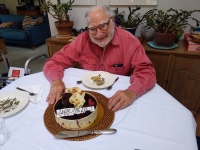
I am sorry to tell you that Arthur, my dear husband of 67 years
died peacefully yesterday, June 30, at home, surrounded by his
family. It was 2 days after his 90th birthday. The cause was pulmonary
fibrosis, which affected him for 19 years. While he was physically
debilitated by this disease, his mind remained sharp and clear to
the end.
But do not be too sad. He had a wonderful life, one that exceeded
our expectations. He was a pioneering scientist in his field of
relativistic nuclear collisions, a co-discoverer of collective
flow, and the author on a number of seminal papers in physics. He
was respected and admired by his peers and colleagues, and enjoyed
a life of worldwide travel, many adventures, interesting colleagues,
and lots of good food and wine. He was blessed by loving children
and grandchildren, with many wonderful memories to hold in their
hearts.
Shortly before he died, Arthur completed an oral history for the
American Institute of Physics. I am attaching the
link
for those of you who haven't already seen it.
I am also attaching a photograph taken on his 90th birthday.
Burial with be private with just the family, but there will be a
celebration of life at some time in the future.
With my fondest regards to you all,
Lucille
Deborah Poskanzer
Dear Friends and Family,
I write in sorrow to tell you that my father, Arthur Poskanzer,
passed away peacefully in his bed yesterday, two days after his
90th birthday. He had been ill for some time and we are relieved
that his suffering is at an end. May his memory be a blessing.
There will be a very small graveside service at Sunset View next
week, followed by a much larger memorial in celebration of his life
and work in a few months. My father did not have any favorite
charities, but if you wish to make a donation in his honor, please
give to the cause of your choice.
Thank you all for your support and kindness.
Deb
Helen Caines
Dear Collaborators,
We are very sad to be forwarding along the news from our
LBNL colleagues that Arthur (Art) Poskanzer passed away on
Wednesday, June 30, just two days after his 90th birthday.
Art led many of the original analyses on flow from STAR,
and was a great mentor to many who are still active in the
collaboration and the larger field. I was talking to him
only last week about some our results.
Please see the note below from Grazyna on behalf of the RNC
group with more details on Art's career and an invitation
to sign the condolence card for his family.
Helen and Lijuan
Grazyna Odyniec
Art received his Ph.D. from MIT in physical chemistry in 1957 and
was a chemist at BNL from 1957 to 1966. After that, Art had been
with LBNL until his retirement as Distinguished Senior Scientist
Emeritus in 2001.
Art was one of the founding fathers of the relativistic heavy ion
collision field. He formed the Relativistic Nuclear Collision Program
in the Nuclear Science Division at LBL. He was the author of numerous
papers including the flow method paper which many of you cited, and
the first STAR publication on elliptic flow which led to the discovery
of Quark Gluon Plasma. Art received the 2008 Tom W. Bonner prize
"in recognition of his pioneering role in the experimental studies
of flow in relativistic heavy ion collisions." He just gave an
interview about his career for the American Institute of Physics a
few months ago
Art had been continuously active after his retirement, writing his
code to do the analyses and publishing papers. He was an inspirational
mentor with always a smile on his face. Art will be missed by all
of us. Our thoughts are with his wife, Lucille, his children, and
grandchildren.
We will plan a celebration of his accomplishments and contributions
to the field as soon as pandemic restrictions are lifted. For now,
if you wish, please sign the condolence card for his family.
Grazyna for the RNC group at LBNL
Mike Lisa
Dear Collaborators,
I am sure there will be several mails of this sort, and I'm
sorry if this seems like spam. I will keep it short.
The younger members of this field should know that this was
a great man. He was instrumental in founding our field,
and his enthusiasm and energy inspired a generation and
more. Art was the one who hired me as a postdoc at LBNL
in 1993, and I can say with no hesitation that he was ALWAYS
a pleasure to talk with, ALWAYS had time for a young person
and their questions, and ALWAYS with warmth, intelligence
and keen attention.
We have many wonderful colleagues in our field, and we
should cherish them while we are all still here. But there
was only one Art.
Mike
Hao Qiu
Dear Collaborators,
This is shocking sad news. I still remember Art coming to office
everyday, writing code, doing analysis, publish papers, joining
group meetings and helping us juniors at an age close to 90, after
so many great achievements as listed in this email thread. He just
love doing science. And he is kind to everyone in the group, always
glad to help young people. We will always remember Art, and continue
to contribute to this vigorous field, of which Art was one of the
founding fathers.
Hao
Shusu Shi
Dear STAR collaborators,
In many people's minds, Art always had a kind smile. He was always
absorbed in his work, patiently answered young people's questions.
Even in the debate, he was firm but gentle. Many of our CCNU
colleagues were helped by Art during their visits to Berkeley: Feng
Liu, Jinghua Fu, Yan Lv, Mingmei Xu, Xiaofeng Luo, Na Li, Yaping
Wang, Jiayun Chen, Xun Sun, Shaowei Lan et al... His profound
knowledge and rigorous academic attitude deeply influenced us. We
were very lucky to have published many papers with him. We miss the
days when we had lunch together after the RNC group meeting every
Monday.
Art was one of the founders of STAR, also was a pioneer expert in
collective flow. He led the publication of STAR's first paper
"Elliptic Flow in Au+Au Collisions at sqrt(sNN) = 130 GeV" (768
citations). The measurement method of collective flow developed by
him and his collaborators has an important influence on the whole
field.
We will miss Art forever!
Shusu Shi on behalf of STAR-CCNU group
George Stephans
To all,
Art was that rare combination of brilliant scientist and wonderful
human being. His willingness to discuss physics with people at any
level, without haughtiness or condescension, was a joy to behold.
I don't remember him ever being anything other than truly excited
to talk to others about his results, or their results, or usually
both, typically with some deep insight about any connections. He
excelled at being both a physicist and a warm and welcoming person,
and will be missed for both qualities.
Younger folks might not know that the very idea of studying flow
at RHIC energies was initially dismissed as an utter waste of time
by many experienced people in our community. Art disagreed and
plowed ahead, developing techniques and studying data. He was right,
of course, and flow observables turned out to one of the most
important, if not THE most important, tools in our understanding
of heavy ion physics at RHIC energies and beyond.
Sadly,
George
Catherine THIBAULT
Thank you for your mail even if it is for sad news. My last
contacts with Art were in 2020 when Robert Klapisch died
in March.
I liked very much the work in collaboration with Art since
he was a very excellent physicist. He was really very
passionate about Physics so that it was always very interesting
to exchange with him. In particular he was collaborating
with us for the paper which has been mentioned for the year
1975 when celebrating the 125 years of the Physical review.
This publication will also be mentioned for the 50 years
of IN2P3 (the french Institute for nuclear and particle
physics)
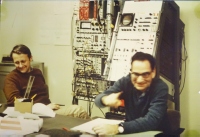
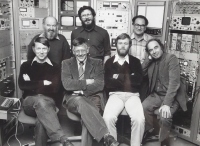
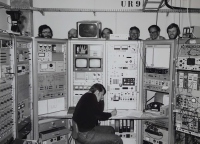 I join you the only 3 pictures from that time where Art is
in the picture. The quality of the 1st one with E. Roeckl
is rather poor and Art is blurry, but it exactly reflects
how much he was passionate! The 2 others have probably
been taken at Isolde. I don't know if you already had them.
I join you the only 3 pictures from that time where Art is
in the picture. The quality of the 1st one with E. Roeckl
is rather poor and Art is blurry, but it exactly reflects
how much he was passionate! The 2 others have probably
been taken at Isolde. I don't know if you already had them.
And finally, last but not least, Art was a very human person
taking care of everyone around him...
Best regards
Shusu Shi
Dear Peter, Miklos, John, Barbara, Volker, Mike, Grazyna,
Hans Georg, James, Sergei, Xin-Nian, Howard, and Nu
We are exceedingly sorry to hear that Art passed away. The
painful news reached us this morning, and we were so shocked
that we could not at first realize the fact. Many of our
CCNU colleagues have visited LBL-RNC group and been helped
by Art. He was always very patient to answer questions,
deeply pointed out the problem and put forward solutions.
Personally, during my doctoral and postdoctoral studies in
Berkeley, we had a lot of discussions and published four papers
together. After work, we had lunch after the group meeting,
and also went to the Jupiter bar to drink together.
Art is our good mentor and friend. Art is a pioneer exporter
on collective flow. CCNU has focused on this topic for many
years. We inherited the measurement method of collective
flow proposed by him and his collaborators, and achieved
some important STAR findings. In the future heavy ion
collision experiments, Art's original work will continue
to be inherited and developed.
We wish there were something we could do or say to soften
the grief. Please pass on our sincere comfort to Art's
family! We will miss Art forever!
Shusu Shi on behalf of STAR-CCNU group
Berndt Mueller
Dear All:
I am deeply saddened to learn about Art's death - he was
one of the scientists I greatly admired. I first met him
in 1972 when I stayed in Berkeley for a summer as a visiting
graduate student at the time when preparation for the Bevalac
were underway. In many respects, Art was the "father" of
modern relativistic heavy ion physics. He stood out in the
field as a deep thinker and meticulous experimenter with a
brilliant intuition for where great discoveriescould be
made. Just this week I read the oral history interview he
gave for the APS. Our field has lost a great scientist and
an admirable human being.
Please accept my condolations to this loss.
Berndt
Larry McLerran
Dear Colleagues,
I read this in the early morning, and I became very sad. I
knew Art from the old days. His work was seminal and of
central importance for the development of the field. I
remember him as a vibrant human being for whom his science
was not merely an intellectual pursuit. Like all of the
really great scientists I have known, his work arose from
his soul, and the intensity with which he felt what he did.
His work, and its impact, arose from the passion that drove
him.
I will deeply miss Art. He was a true scientist, and his
impact is something that we all feel. He will live on through
his ideas and accomplishments. Still, this makes me very
sad to know he is gone.
Sincerely,
Larry McLerran
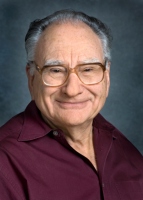
Art Poskanzer, Distinguished Senior Scientist Emeritus in
the Nuclear Science Division at LBNL, died peacefully at
home on June 30 after a long illness, two days after his
90th birthday.
Art was an outstanding scientist, who maintained an active
research career for over sixty years. He began his career
as a nuclear chemist at Brookhaven National Laboratory,
carrying out the first computer simulations of proton
interactions in nuclei in the late 1950s. He moved to
Lawrence Berkeley Laboratory in 1966 to join Earl Hyde's
group, later the Poskanzer-Hyde group, in the Nuclear
Chemistry Division. He was one of the first users of the
Bevatron for nuclear physics, discovering many neutron-rich
isotopes of light nuclei. When nuclear beams were introduced
in the Bevatron, converting it into the Bevalac, Art formed
an international collaboration with Rudolf Bock and Reinhard
Stock from Germany to exploit the new facility. In the first
years of Bevalac operation with Argon beams, they mapped
out the geometry of the collisions. However, they quickly
realized that more sophisticated apparatus, and heavier
beams, would be needed to elucidate the reaction mechanism.
Art, together with Hans Gutbrod and Hans-Georg Ritter, then
developed the Plastic Ball, the first large-acceptance
detector for heavy-ion physics that was used at the upgraded
Bevalac to discover the collective flow of nuclear matter,
which still today is an essential tool for the study of
nuclear matter at all energies. The Plastic Ball was then
moved to CERN, and was installed at the SPS as part of their
new heavy ion program. When the Relativistic Heavy Ion
Collider was approved for construction in the early 1990s,
Art convened a working group at Berkeley and hosted a series
of seminars, to decide what kind of detector to propose.
The outcome was the STAR detector, which was the only one
of nine candidate RHIC detectors to be approved and built
as proposed, and which continues to produce world-class
physics today.
In 1980 Art won the Seaborg Award from the American Chemical
Society, and 2008 he was awarded the Bonner Prize by the
American Physical Society "in recognition of his pioneering
role in the experimental studies of flow in Relativistic
Heavy Ion Collisions." Art is one of very few scientists
to have won both awards.
Art had a profound influence at LBNL, as scientific director
of the Bevalac and as founder of the Relativistic Nuclear
Collisions program in the NSD. He retired in 2002 but stayed
active - for many years, his definition of retirement was
not to come to the office on Wednesdays. He continued to
carry out physics analyses and to collaborate widely, still
producing papers and attending seminars until just a few
years ago.
Art and Lucille met as students at Harvard, and were married
for 67 years. They loved going to restaurants, and in 1978
they started a newsletter of reviews called
"Restaurants in the Berkeley Area,"
which is renowned in the San Francisco
Bay Area - the latest update was in 2020.
Art was mentor and friend to many scientists in the heavy
ion community. He was beloved for his sharp humor, his
critical eye, and his very high standards. He will be sadly
missed.
Art is survived by Lucille, their children and spouses
Deborah and Alan, Harold and Marjorie, and Jef, and
grandchildren Felix, Leo, Frieda, and Henry. Alan (Meier)
is a Senior Scientist in the Building Technology and Urban
Systems Division at LBNL.
A commemoration of Art's life will be held in the near future.

Arthur M. Poskanzer
June 28, 1931-June 30, 2021
Arthur M Poskanzer, a Distinguished Senior Scientist Emeritus
at Lawrence Berkeley National Laboratory, and a pioneering
Nuclear Physicist died peacefully at home in Berkeley CA,
2 days after his 90th birthday, surrounded by his loving
family. The cause was Pulmonary Fibrosis, which affected
him for 19 years.
He was born in New York City, and was a graduate of Stuyvesant
High School. He graduated cum laude in Physics and Chemistry
from Harvard, then continued on to Columbia University for
his M.A. He received his PhD from MIT.
He came to Berkeley in 1966 after 9 years at Brookhaven
National Laboratory, and joined the Nuclear Science Division,
where he remained for over 50 years.
Among the many highlights of his scientific career, he was
best known for his co-discovery of collective and elliptic
nuclear flows, major experimental evidence leading the
discovery of the Quark Gluon Plasma.
He was the first scientific director of the Bevalac
accelerator, the co founder of the STAR collaboration at
the Relativistic Heavy Ion Collider (RHIC), and one of the
leading organizers behind the Heavy Ion program at CERN in
Geneva, Switzerland.
Among his many awards were the Glenn Seaborg award in Nuclear
Chemistry from the American Chemical Society, and the Bonner
prize in Experimental Nuclear Physics from the American
Physical Society. He was one of very few scientist who have
won awards from both organizations. During is long career,
he also received a Guggenheim Fellowship, an Alexander von
Humboldt award, and a NATO Senior Fellowship, to name just
a few.
Arthur was known for the excellence and rigor of his
scientific publications. When Physical Review C, the nuclear
physics journal of the American Physical Society celebrated
its 50th Anniversary by citing 25 "milestone" papers, he was
an author on 4 of them.
Despite all of his accomplishments, he was modest and humble,
and was always available to advise and encourage younger
scientists. He impressed these younger scientists with his
computer skills, writing code and developing programs well
into his 80's. His mind remained active and curious until
the very end.
He leaves Lucille, his wife of 67 years, his children Deborah
(spouse Alan Meier), Jef, Harold (spouse Marjorie Wechsler),
and 4 grandchildren.
He will be dearly missed by many many people.
To plant trees in memory, please visit our
Sympathy Store.
Published by San Francisco Chronicle from Jul. 9 to Jul. 11, 2021.
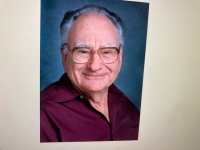
Remembering Art Poskanzer, experimental physicist who co-discovered collective flow
Poskanzer, 90, won the Bonner Prize in Experimental Nuclear Physics. He was a supporter of Berkeleyside and the Berkeley Path Wanderers Association and created a free online guide to dining in Berkeley with his wife, Lucille.
Art Poskanzer, June 28, 1931 - June 30, 2021
Arthur Poskanzer, an early and consistent supporter of Berkeleyside, died on June 30, two days after his 90th birthday. He was surrounded by his loving family and the end was peaceful. The cause was pulmonary fibrosis, which affected him for 19 years.
Art and his family moved to Berkeley in 1967 during some exciting times, and they never left. He joined the nuclear science division at Lawrence Berkeley National Lab, where he remained for over 50 years. He was designated as a distinguished senior scientist, and became emeritus after his retirement.
Art was a pioneering nuclear physicist in the field of high energy relativistic nuclear collisions, a co-discover of collective and elliptic flow, essential experimental evidence leading to the discovery of the Quark-gluon plasma, "an ephemeral state of matter believed to have existed in the first few microseconds after the universe was born." In his earlier scientific career, he was noted for the discovery of isotopes far from stability which were predicted not to exist.
He was the recipient of many awards and honors, among them the 1980 Glenn T. Seaborg Award for Nuclear Chemistry from the American Chemical Society and the 2008 Tom W. Bonner Prize in Experimental Nuclear Physics from the American Physical Society for his "experimental studies of flow in Relativistic Heavy Ion Collisions." He is one of very few scientists to win awards from both organizations.
Art was known for the rigor and excellence of his scientific papers, some of which became seminal to his field, with many, many citations.
But despite all the honors, Art was modest and humble, always willing to encourage and talk to younger scientists. They were impressed with his computer skills, writing code and developing programs well into his 80s.
Art loved Berkeley. He was an early supporter of the Berkeley Path Wanderers Association and enjoyed the programs and neighborhood walks of the Berkeley Historical Society. He spent many hours hiking and biking in Tilden Park.
He and his wife, Lucille, along with their sons, created a guide to restaurants in Berkeley and Oakland that was available to everyone free online. They maintained this site until just recently, and it was a great resource for the community.
Art leaves Lucille, his wife of 67 years; children Deborah (spouse, Alan Meier), Jef (who is a frequent contributor of photographs to Berkeleyside) and Harold (spouse, Marjorie Wechsler); and four grandchildren.
He had a wonderful life.

'A pioneer': Arthur Poskanzer, nuclear physics scientist emeritus, dies at 90
Distinguished senior scientist emeritus Arthur Poskanzer spent the majority of his career working at the Lawrence Berkeley National Laboratory, or Berkeley Lab, where he developed some of his great achievements in nuclear physics. He died June 30, two days after his 90th birthday.
Poskanzer was constantly thinking. During hikes in the woods or at home, sitting in his chair and propping his feet up on the ottoman, Poskanzer sought out his scientific notions through moments of silence, according to Lucille Poskanzer, his wife of 67 years. Once he thought of something, he would whip out the little voice recorder he stored in his pocket and start speaking.
"He would do that in the middle of the night," Lucille Poskanzer said. "I would wake up and there he was, talking into his recorder. I thought he was dreaming, but he wasn't dreaming, he was having ideas."
Arthur Poskanzer had a "linear" train of thought, according to Lucille Poskanzer. His thoughts, when left uninterrupted, would lead to the beginnings of multiple ventures through which he gained notoriety among the nuclear sciences community.
A pioneer in particle physics and nuclear chemistry, Arthur Poskanzer won multiple awards for his leadership in these fields, including the Glenn T. Seaborg Award for Nuclear Chemistry from the American Chemical Society and the Tom W. Bonner Prize for experimental nuclear physics from the American Physical Society, according to an SFGate article.
Arthur Poskanzer was the first scientific director of the Bevalac accelerator and co-developed the Plastic Ball, a detector that aided in discovering the collective flow of nuclear matter and remains an essential tool in studying it, according to the Berkeley Lab website.
At the Relativistic Heavy Ion Collider program, or RHIC, at Brookhaven National Laboratory, Arthur Poskanzer co-founded the Solenoid Tracker at Relativistic Heavy Ion Collider, or STAR collaboration. In addition, Arthur Poskanzer was a leading organizer of the heavy-ion program at the European Council for Nuclear Research, or CERN, an atomic physics laboratory, the American Physical Society added.
"He held himself to a very high standard and he held the people about him to a very high standard," said Peter Jacobs, a senior scientist at Berkeley Lab and former colleague of Arthur Poskanzer. "He was driven by the challenge of debating with nature."
While he retired in 2002, Arthur Poskanzer continued to return to Berkeley Lab for more than a decade in pursuit of his passion for science and mentoring young scientists with his concept of retirement being Wednesdays off, Jacobs noted.
Arthur Poskanzer died from pulmonary fibrosis, which had affected him starting about the time of his retirement, according to the SFGate article. He is survived by Lucille Poskanzer, their three children and four grandchildren.
"I was absolutely astonished by the number of emails that I got after he died and all the tributes that came in with memories of people's interactions with him," Lucille Poskanzer said. "You never can assess how many people a person has influenced in their life. And he influenced a lot of people."
Jef Poskanzer
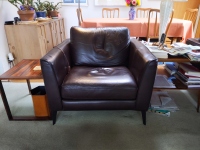
And my own tribute.
When we move on from this life, what do we leave behind?
I've done some thinking about this, and for me it comes down to three things:
children, of course; things we created; and people we taught.
Art taught me to read books, ride bikes, take photos, and program computers,
all four of which I still do every day.
I was happy to be Art's son, but I was honored and blessed to be his student.
Anyway. Goodbye Art.

Jef's page








